The Effect of Students’ Material Status and Zoom Fatigue on Their Perception of Emergency Remote Teaching Satisfaction and Remote Teaching Sustainability from the Perspective of Education Faculty Students in Serbia
Abstract
1. Introduction
- Whether the students’ material status contributes to differences in their preference for emergency remote teaching and attitudes towards the possibility of attending RT again.
- Whether the students’ material status contributes to differences in the Zoom Fatigue level during their attendance of emergency remote teaching.
- Whether, based on the students’ material status, their preferences for emergency remote teaching, and attitude towards the possibility of attending remote teaching again, it is possible to predict the Zoom Fatigue level during the implementation of emergency remote teaching.
1.1. Social and Digital Inequalities in Emergency Remote Teaching
1.2. The Negative Health Effects of Emergency Remote Teaching
2. Materials and Methods
- Sociodemographic features: Gender and place of origin.
- Matters regarding the students’ status:Level of study, GPA, and students’ status.
- Matters regarding the economic status: Method of financing studies and monthly household income.
- Matters regarding ERT: Preferences for ERTand the possibility of attending RT again.
- Zoom Exhaustion and Fatigue Scale [91]: The ZEF scale is an instrument intended for assessing the respondents’ fatigue intensity and the modality of their fatigue after attending remote teaching. The scale consists of 15 items, with 3 items for each of the five fatigue modalities: general, visual, social, emotional, and motivational (e.g., “I felt tired after attending the remote lesson”). Moreover, the overall result on the scale is also taken into account. The respondents gave answers on a five-point Likert scale (from “1 = Strongly disagree” to “5 = Strongly agree”). The scale reliability measured by Cronbach’s alpha in the original research was between 0.82 and 0.90 [91], between 0.70 and 0.91 [96], and between 0.87 and 0.92 [97].
- Place of origin: Whether before starting university studies, the student lived in a city, a suburban settlement, or a village.
- Level of studies: Bachelor’s (4 years long, with 240 ECTS) and master’s (1 year long, with 60 ECTS).
- The range of the achieved GPA in the following categories: 6–7, 7–8, 8–9, 9–10 (at Serbian universities, the lowest pass mark is 6 and the highest is 10).
- Students’ status: Onthe state budget or self-financing.
- Type of financing the costs of studying: financed by family members; the student works and finances the costs of studying on his/her own.
- Monthly household income: Much below average (under RSD 65,000), below average (RSD 65,000–90,000), average (90,000–130,000), above average (130,000–170,000), much above average (more than RSD 170,000). The starting basis for this categorization was the amount of the median salary in the Republic of Serbia of RSD 63,954 in April 2023, which means that 50% employees earned up to the above-mentioned amount [98], while the median pension was between RSD 20,000 and 25,000 [99]. However, having in mind that in Serbia there is still a trend of multigenerational common households, which is a characteristic of transitioning societies in general [100], it is also possible that the household was able to increase its income in a different manner. Some of the members of multigenerational households were able (via social subsidies by the state, or self-employment in their private or family business or agriculture) to acquire additional income in the amount of approximately ½ of the average monthly salary. The above-mentioned categories were formed under the assumption that at least one family member earned RSD 25,000 as a median pension.
- Preference for ERT: The question refers to how much the students generally liked emergency remote teaching (I did not like it at all; I saw it as a necessary evil; I liked it very much).
- The attitude toward the possibility of attending RT again: The students answered the question in which circumstances they found it acceptable to attend RT again (never, in extraordinary circumstances, to introduce it as a permanent form of teaching).
- The question regarding difficulties brought by the introduction of ERT to students in terms of their economic position: On a five-point Likert scale (from “1 = Strongly disagree” to “5 = Strongly agree”), the respondents assessed the following statement: “What I minded in ERT was the lack of financial means for buying enough internet with a sufficient flow speed”.
3. Results
3.1. Descriptive Statistics of Variables
3.2. Material Status, ERT, and RT
3.3. Material Status and ZEF During the Attendance of ERT
3.4. The Possibility of Prediction ZEF
4. Discussion
5. Conclusions
Author Contributions
Funding
Institutional Review Board Statement
Informed Consent Statement
Data Availability Statement
Conflicts of Interest
Abbreviations
| RT | Remote Teaching |
| ERT | Emergency Remote Teaching |
| ZF | Zoom Fatigue |
| ZEF | Zoom Exhaustion and Fatigue Scale |
| GPA | Grade Point Average |
| GDP | Gross Domestic Product |
References
- Giroux, H.A. The COVID-19 Pandemic Is Exposing the Plague of Neoliberalism. Social Project. 2020. Available online: https://socialistproject.ca/2020/04/covid19-pandemic-exposing-plague-of-neoliberalism/ (accessed on 1 June 2025).
- Castells, M. Ruptura: La Crisis de la Democracia Libeberal, 3rd ed.; Alianza Editorial: Madrid, Spain, 2020. [Google Scholar]
- Šuvaković, U.V. “New normal”—Not what we expected. In Education Through the COVID-19 Pandemic: Socio-Humanistic Aspects; Mandić, D.P., Šuvaković, U.V., Stanković, D.V., Eds.; University of Belgrade—Faculty of Education: Belgrade, Serbia, 2024; Volume 2, pp. 772–793. [Google Scholar] [CrossRef]
- Kissinger, H.A.; Schmidt, E.; Huttenlocher, D. The Age of AI: And Our Human Future; John Murray: London, UK, 2021. [Google Scholar]
- Althusser, L. Idéologie et AppareilsIdéologique (Notes pour Une Recherche). Available online: https://classiques.uqam.ca/contemporains/althusser_louis/ideologie_et_AIE/ideologie_et_AIE_texte.html (accessed on 1 June 2025).
- Bourdieu, P.J.; Passeron, C. La Reproduction: Élements pour Une Théorie du Système d’Enseignement. Available online: https://www.persee.fr/doc/autog_0338-7259_1971_num_15_1_1007_t1_0149_0000_1 (accessed on 1 June 2025).
- Kaiser, Z. School’s Back: How the Neoliberal “Privatization of Risk” Explains the Deadly Decision to Re-Open Campuses. London School of Economics and Political Science (LSE). Available online: https://blogs.lse.ac.uk/impactofsocialsciences/2020/10/08/schools-back-how-the-neoliberal-privatization-of-risk-explains-the-deadly-decision-to-re-open-campuses/ (accessed on 1 June 2025).
- Collins, J. Social reproduction in classrooms and schools. Annu. Rev. Anthropol. 2009, 38, 33–48. [Google Scholar] [CrossRef]
- Gillborn, D. Education policy as an act of white supremacy: Whiteness, critical race theory and education reform. J. Educ. Policy 2005, 20, 485–505. [Google Scholar] [CrossRef]
- Breen, R. Social mobility and equality of opportunity geary lecture spring. Econ. Soc. Rev. 2010, 41, 413–428. [Google Scholar]
- Jelačić, S. Education in context of educational inequalities. In Proceedings of the First International Interdisciplinary Conference for Young Scholars in Social Sciences and Humanities—Contexts: Book of Proceedings, Novi Sad, Serbia, 1 December 2012; Available online: https://digitalna.ff.uns.ac.rs/sadrzaj/2014/978-86-6065-292-0 (accessed on 11 April 2025).
- Čović, A. Right to privacy and protection of personal data in the age of the COVID-19 pandemic. Sociol. Pregl. 2020, 54, 670–697. [Google Scholar] [CrossRef]
- Jevtović, Z.B.; Bajić, P.Đ. The image of COVID-19 in the Serbian daily newspapers. Sociol. Pregl. 2020, 54, 534–559. [Google Scholar] [CrossRef]
- Marković Savić, O.S. Crisis and organised control: The COVID-19 pandemic and power of surveillance. Sociol. Pregl. 2020, 54, 647–669. [Google Scholar] [CrossRef]
- Mirović, D.M. Violation of universal human rights and persecution of the Serbian Orthodox Church in Montenegro during the COVID-19 epidemic. Sociol. Pregl. 2020, 54, 720–736. [Google Scholar] [CrossRef]
- Smedovska Toneva, R. The State of Emergency as an Instrument of Crisis Management. In In Honor of Professor ĐorđeTasić: Life, Works and Echoes; Editions of Sociološki pregled; Miladinović, S., Vuković, A., Eds.; Serbian Sociological Association: Belgrade, Serbia, 2023; Volume 3, pp. 305–314. [Google Scholar] [CrossRef]
- Beaunoyer, E.; Dupéeré, S.; Guitton, M.J. COVID-19 and digital inequalities: Reciprocal impacts and mitigation strategies. Comput. Hum. Behav. 2020, 111, 106424. [Google Scholar] [CrossRef] [PubMed]
- Šuvaković, U.V. On the methodological issue of uncritical adoption of concepts using the example of the concept “social distance” during the COVID-19 pandemic. Sociol. Pregl. 2020, 54, 445–470. [Google Scholar] [CrossRef]
- Nguyen, M.H.; Hargittai, E.; Marler, W. Digital inequality in communication during a time of physical distancing: The case of COVID-19. Comput. Hum. Behav. 2021, 120, 106717. [Google Scholar] [CrossRef]
- Guzzo, T.; Ferri, F.; Grifoni, P. Lessons learned during COVID-19 and future perspectives for emerging technology. Sustainability 2023, 15, 10747. [Google Scholar] [CrossRef]
- Tilak, J.B.G.; Kumar, A.G. Policy Changes in Global Higher Education: What Lessons Do We Learn from the COVID-19 Pandemic? High Educ. Policy 2022, 35, 610–628. [Google Scholar] [CrossRef]
- Šuvaković, U.; Nikolić, I.; Petrović, J. University classes during the state of emergency in Serbia introduced after the outbreak of the COVID-19 pandemic crisis: Students’ attitudes. Zb. Inst. Za Pedagoš. Istraž. 2022, 54, 241–278. [Google Scholar] [CrossRef]
- Petrović, J.R.; Šuvaković, U.V.; Nikolić, I.A. Sustainability of Remote Teaching in Serbia: Post-Pandemic Perspectives from Education Faculty Students. Sustainability 2025, 17, 2769. [Google Scholar] [CrossRef]
- Dabetić, V. Online teaching: Education in times of crisis or education of the future? Anal. Pravnog Fak. Beogr. 2022, 70, 1165–1190. [Google Scholar] [CrossRef]
- Almazova, N.; Krylova, E.; Rubtsova, A.; Odinokaya, M. Challenges and Opportunities for Russian Higher Education amid COVID-19: Teachers’ Perspective. Educ. Sci. 2020, 10, 368. [Google Scholar] [CrossRef]
- Ferri, F.; Grifoni, P.; Guzzo, T. Online learning and emergency remote teaching: Opportunities and challenges in emergency situations. Societies 2020, 10, 86. [Google Scholar] [CrossRef]
- Tulaskar, R.; Turunen, M. What students want? Experiences, challenges, and engagement during Emergency Remote Learning amidst COVID-19 crisis. Educ. Inf. Technol. 2022, 27, 551–587. [Google Scholar] [CrossRef]
- Ignjatović, G. Systemic agency in education in extraordinary circumstances: Challenges encountered by LF Niš during the COVID-19 pandemic and opportunities for developing systemic agency in legal education. Zb. Rad. Pravnog Fak. Nišu 2022, 61, 65–97. [Google Scholar] [CrossRef]
- Vidosavljević, M.M. Teachers experiences in relation to online teaching/learning during the COVID-19 pandemic. Baština 2022, 56, 435–449. [Google Scholar] [CrossRef]
- Jakovljević, N.G. Attitudes of secondary vocational school students in Serbia on the use of digital technologies when conducting emergency distance teaching during the COVID-19 pandemic in the subject of sociology. Metod. Teor. Praksa 2024, 27, 34–49. [Google Scholar] [CrossRef]
- Fidalgo, P.; Thormann, J.; Kulyk, O.; Lencastre, A.J. Students’ perceptions on distance education: A multinational study. Int. J. Educ. Technol. High. Educ. 2020, 17, 18. [Google Scholar] [CrossRef]
- Bojić, K.; Brdar, I.; Nešić, M. Do We Talk to a Wallor Passon Knowledge to Students—The Advantages and Disadvantages of Online Learning. Marketing 2022, 53, 284–294. [Google Scholar]
- Archibald, D.; Worsley, S. The father of Distance Learning. TechTrends 2019, 63, 100–101. [Google Scholar] [CrossRef]
- Juszczyk, S.; Kim, S. Distance learning in the Polish and Korean universities During COVID–19 pandemic. New Educ. Rev. 2020, 62, 115–127. [Google Scholar] [CrossRef]
- Koet, T.W.; Aziz, A.A. Teachers’ and students’ perceptions towards distance learning during the COVID–19 pandemic: A systematic review. Int. J. Acad. Res. Progress. Educ. Dev. 2021, 10, 531–562. [Google Scholar] [CrossRef] [PubMed]
- Bond, M.; Bedenlier, S.; Marín, V.I.; Händel, M. Emergency remote teaching in higher education: Mapping the first global online semester. Int. J. Educ. Technol. High. Educ. 2021, 18, 50. [Google Scholar] [CrossRef]
- Nikolić, V.; Miladinović, T. University Teaching in Serbia during the COVID-19 Pandemic. Nastava Vasp. 2024, 73, 97–114.46. [Google Scholar] [CrossRef]
- Bozkurt, A.; Sharma, R.C. Emergency remote teaching in a time of global crisis due to CoronaVirus pandemic. Asian J. Distance Educ. 2020, 15, i–vi. [Google Scholar] [CrossRef]
- Jandrić, P.; Hayes, D.; Truelove, I.; Levinson, P.; Mayo, P.; Ryberg, T.; Monzó, L.D.; Allen, Q.; Stewart, P.A.; Carr, P.R.; et al. Teaching in the age of COVID-19. Postdigital Sci. Educ. 2020, 2, 1069–1230. [Google Scholar] [CrossRef]
- Hodges, C.; Moore, S.; Lockee, B.; Trust, T.; Bond, A. The Difference Between Emergency Remote Teaching and Online Learning. Educause Rev. 2020, 27, 511–522. [Google Scholar]
- Savić, I.; Alčaković, S. Experiences of university students and their attitudes towards online learning during the COVID-19 pandemic. Eur. J. Appl. Econ. 2022, 19, 84–96. [Google Scholar] [CrossRef]
- Kulić, D.G.; Janković, A.V. Emergency remote teaching during the pandemics at tertiary level of education—Students’ perspective. Baština 2022, 56, 481–494. [Google Scholar] [CrossRef]
- Stepanović, S. The Impact of the COVID-19 Pandemic on Education. Nastava Vasp. 2020, 69, 183–196. [Google Scholar] [CrossRef]
- Sundarasen, S.; Chinna, K.; Kamaludin, K.; Nurunnabi, M.; Baloch, G.M.; Khoshaim, H.B.; Hossain, S.F.A.; Sukayt, A. Psychological impact of COVID-19 and lockdown among university students in Malaysia: Implications and policy recommendations. Int. J. Environ. Res. Public Health 2020, 17, 6206. [Google Scholar] [CrossRef] [PubMed]
- MacIntyre, P.D.; Gregersen, T.; Mercer, S. Language teachers’ coping strategies during the COVID-19 conversion to online teaching: Correlations with stress, well being and negative emotions. System 2020, 94, 102352. [Google Scholar] [CrossRef]
- Williamson, B.; Eynon, R.; Potter, J. Pandemic politics, pedagogies and practices: Digital technologies and distance education during the corona virus emergency. Learn. Media Technol. 2020, 45, 107–114. [Google Scholar] [CrossRef]
- Doornbos, L. Emergency remote learning: Seeing, understanding and disrupting racism. J. Int. Soc. Stud. 2020, 10, 76–89. [Google Scholar]
- Whittle, C.; Tiwari, S.; Yan, S.; Williams, J. Emergency remote teaching environment: A conceptual framework for responsive online teaching incrises. Inf. Learn. Sci. 2020, 121, 311–319. [Google Scholar] [CrossRef]
- Francis, D.V.; Weller, C.E. Economic Inequality, the Digital Divide, and Remote Learning During COVID-19. Rev. Black Political Econ. 2022, 49, 41–60. [Google Scholar] [CrossRef]
- Aguliera, E.; Nightengale-Lee, B. Emergency remote teaching across urban and rural contexts: Perspectives on educational equity. Inf. Learn. Sci. 2020, 121, 471–478. [Google Scholar] [CrossRef]
- Galperin, H.; Bar, F.; Kim, A.M.; Le, T.; Daum, K. Connected Cities and Inclusive Growth (ccig) Policy Brief 6: The Distance Learning Gap in California. 2020. Available online: http://arnicusc.org/wp-content/uploads/2020/04/Policy-Brief-6.pdf (accessed on 1 June 2025).
- Owusu-Fordjour, C.; Koomson, C.K.; Hanson, D. The impact of COVID-19 on learning-the perspective of the Ghanaian student. Eur. J. Educ. Stud. 2020, 7, 88–101. [Google Scholar] [CrossRef]
- Cortez, H.L.; Schrijver, I. Advantages and Challenges of Online Translation Teaching and Learning During the COVID-19 Pandemic: A Mexican Case Study. Inov. U Nastavi 2021, 34, 1–12. [Google Scholar] [CrossRef]
- Boskić, N.; Hausknecht, S. Reshaping the educational landscape: During and after the COVID19 pandemic. Inov. U Nastavi 2021, 34, 36–50. [Google Scholar] [CrossRef]
- Toquero, C.M.D.; Calago, P.A.; Pormento, S.B. Neoliberalism crisis and the pitfalls and glories in emergency remote education. Asian J. Distance Educ. 2021, 16, 90–97. [Google Scholar] [CrossRef]
- Rotas, E.E.; Cahapay, M.B. Difficulties in remote learning: Voices of Philippine university students in the wake of COVID-19 crisis. Asian J. Distance Educ. 2020, 15, 147–158. [Google Scholar] [CrossRef]
- Adnan, M.; Anwar, K. Online learning amid the COVID-19 pandemic: Students’ perspectives. J. Pedagog. Sociol. Psychol. 2020, 2, 45–51. [Google Scholar] [CrossRef]
- Andrews, G.; Fouche, I. Emergency Remote Teaching in Unequal Contexts: Reflections on Student Feedback on Two Online Courses during the COVID-19 Lockdown in South Africa. Int. J. Inf. Educ. Technol. 2022, 12, 518–528. [Google Scholar] [CrossRef]
- Noursani, S. Social Exclusive of Education Inequality in the COVID-19 Pandemia by Education Digitalization Activities. QALAMUNA J. Pendidik. Sos. Dan Agama 2022, 14, 263–274. [Google Scholar] [CrossRef]
- Mailizar; Almanthari, A.; Maulina, S.; Bruce, S. Secondary school mathematics teachers’ views on e-learning implementation barriers during the COVID-19 Pandemic: The case of Indonesia. Eurasia J. Math. Sci. Technol. Educ. 2020, 16, em1860. [Google Scholar] [CrossRef]
- da Silva Maciel, E.; Lima, L.P.; Quaresma, F.R.P. Social inequalities in remote education in times of pandemic. Rev. Obs. 2021, 7, a5en. [Google Scholar] [CrossRef]
- Ferraro, F.V.; Ambra, F.I.; Aruta, L.; Iavarone, M.L. Distance learning in the COVID-19 era: Perceptions in Southern Italy. Educ. Sci. 2020, 10, 335. [Google Scholar] [CrossRef]
- Alqurshi, A. Investigating the impact of COVID-19 lockdown on pharmaceutical education in Saudi Arabia–A call for a remote teaching contingency strategy. Saudi Pharm. J. 2020, 28, 1075–1083. [Google Scholar] [CrossRef] [PubMed]
- Kapasia, N.; Paul, P.; Roy, A.; Saha, J.; Zaveri, A.; Mallick, R.; Barman, B.; Das, P.; Chouhan, P. Impact of lockdown on learning status of undergraduate and postgraduate students during COVID-19 pandemic in West Bengal, India. Child. Youth Serv. Rev. 2020, 116, 105194. [Google Scholar] [CrossRef]
- Yang, X. Teachers’ Perceptions of Large-Scale Online Teaching as an Epidemic Prevention and Control Strategy in China. ECNU Rev. Educ. 2020, 3, 739–744. [Google Scholar] [CrossRef]
- Bekova, S.K.; Terentev, E.A.; Maloshonok, N.G. Educational Inequality and COVID-19 Pandemic: Relationship between the Family Socio-Economic Status and Student Experience of Remote Learning. Vopr. Obraz./Educ. Stud. Mosc. 2021, 1, 74–92. [Google Scholar] [CrossRef]
- Al-Baadani, A.A.; Abbas, M. The impact of coronavirus (COVID-19) pandemic on higher education institutions (HEIs) in Yemen: Challenges and recommendations for the future. Eur. J. Educ. Stud. 2020, 7, 68–81. [Google Scholar] [CrossRef]
- Mahmud, K. E-learning for tertiary level education in least developed countries: Implementation obstacles and way outs for Bangladesh. Int. J. Comput. Theory Eng. 2010, 2, 150–155. [Google Scholar] [CrossRef]
- Bozkurt, A.; Jung, I.; Xiao, J.; Vladimirschi, V.; Schuwer, R.; Egorov, G.; Lambert, S.; Al-Freih, M.; Pete, J.; Olcott, D., Jr.; et al. A global outlook to the interruption of education due to COVID-19 pandemic: Navigating in a time of uncertainty and crisis. Asian J. Distance Educ. 2020, 15, 1–126. [Google Scholar]
- Mandić, D.; Ristić, M. WEB Portals and Remote Education in the Function of Raising the Quality of Teaching; Mediagraf: Belgrade, Serbia, 2006. [Google Scholar]
- Mićović, D.; Beko, L. Digital Natives and Online Learning in Police Students. Nauka Bezb. Polic. 2022, 27, 29–42. [Google Scholar] [CrossRef]
- Azionya, C.M.; Nhedzi, A. The digital divide and higher education challenge with emergency online learning: Analysis of tweets in the wake of the COVID-19 lockdown. Turk. Online J. Distance Educ. 2021, 22, 164–182. [Google Scholar] [CrossRef]
- Stanistreet, P.; Elfert, M.; Atchoarena, D. Education in the age of COVID-19: Understanding the consequences. Int. Rev. Educ. 2020, 66, 627–633. [Google Scholar] [CrossRef]
- Petrović, J.S.; Miltojević, V.D. Experiences and Lessons Learned: Online Classes at Universities in Serbia During the COVID-19 Pandemic. In Education Through the COVID-19 Pandemic: Socio-Humanistic Aspects; Mandić, D.P., Šuvaković, U.V., Stanković, D.V., Eds.; University of Belgrade—Faculty of Education: Belgrade, Serbia, 2024; Volume 2, pp. 425–438. [Google Scholar] [CrossRef]
- Tziouvara, M.R.; Kakana, D. Family-related factors that deteriorate educational inequalities: The case of emergency remote teaching (ERT) during the COVID-19 pandemic in Greece. Eur. J. Educ. Stud. 2025, 12, 43–76. [Google Scholar] [CrossRef]
- Rohs, M.; Ganz, M. MOOCs and the Claim of Education for All: A Disillusion by Empirical Dana. Int. Rev. Res. Open Distrib. Learn. 2015, 16. [Google Scholar] [CrossRef]
- Hidalgo, A.; Gabaly, S.; Morales-Alonso, G.; Urueña, A. The digital divide in light of sustainable development: An approach through advanced machine learning techniques. Technol. Forecast. Soc. Change 2020, 150, 119754. [Google Scholar] [CrossRef]
- Hargittai, E. Digital na(t)ives? Variation in internet skills and uses among members of the “net generation”. Sociol. Inq. 2010, 80, 92–113. [Google Scholar] [CrossRef]
- van Dijk, J.A.G.M. The Digital Divide; Polity: Cambridge, UK, 2020. [Google Scholar]
- Li, W.; Wang, Z.; Wang, G.; Ip, P.; Sun, X.; Jiang, Y.; Jiang, F. Socioeconomic inequality in child mental health during the COVID-19 pandemic: First evidence from China. J. Affect. Disord. 2021, 287, 8–14. [Google Scholar] [CrossRef]
- Philip, B.V. Escalating suicide rates among school children during COVID-19 pandemic and lockdown period: An alarming psychosocial issue. Indian J. Psychol. Med. 2021, 43, 93–94. [Google Scholar] [CrossRef] [PubMed]
- Hou, T.Y.; Mao, X.F.; Dong, W.; Cai, W.P.; Deng, G.H. Prevalence of and factors associated with mental health problems and suicidality among senior high school students in rural China during the COVID-19 outbreak. Asian J. Psychiatry 2020, 54, 102305. [Google Scholar] [CrossRef]
- Asselmann, E.; Borghans, L.; Montizaan, R.; Seegers, P. The role of personality in the thoughts, feelings, and behaviors of students in Germany during the first weeks of the COVID-19 pandemic. PLoS ONE 2020, 15, e0242904. [Google Scholar] [CrossRef]
- Mseleku, Z. A literature review of E-learning and E-teaching in the era of COVID-19 pandemic. Int. J. Innov. Sci. Res. Technol. 2020, 5, 588–597. [Google Scholar]
- Karalis, T.; Raikou, N. Teaching at the times of COVID–19: Inferences and implications for higher education pedagogy. Int. J. Acad. Res. Bus. Soc. Sci. 2020, 10, 479–493. [Google Scholar] [CrossRef] [PubMed]
- von Keyserlingk, L.; Yamaguchi-Pedroza, K.; Arum, R.; Eccles, J.S. Stress of university students before and after campus closure in response to COVID-19. J. Community Psychol. 2022, 50, 285–301. [Google Scholar] [CrossRef]
- Hopp, M.D.S.; Händel, M.; Bedenlier, S.; Glaeser-Zikuda, M.; Kammerl, S.; Kopp, B.; Ziegler, A. The structure of social networks and its link to higher education students’ socio-emotional loneliness during COVID-19. Front. Psychol. 2021, 12, 733867. [Google Scholar] [CrossRef]
- Voltmer, E.; Köslich-Strumann, S.; Walther, A.; Kasem, M.; Obst, K.; Kötter, T. The impact of the COVID-19 pandemic on stress, mental health and coping behavior in German University students—A longitudinal study before and after the onset of the pandemic. BMC Public Health 2021, 21, 1385. [Google Scholar] [CrossRef]
- Osmanović Zajić, J.; Maksimović, J.; Lazić, N. University education in Serbia during the COVID-19 pandemic—students’ perspective. J. Inst. Educ. Res. 2022, 54, 279–298. [Google Scholar] [CrossRef]
- Bailenson, J.N. Nonverbal overload: A theoretical argument for the causes of Zoom Fatigue. Technol. Mind Behav. 2021, 2, 1–6. [Google Scholar] [CrossRef]
- Fauville, G.; Luo, M.; Queiroz, A.C.M.; Bailenson, J.N.; Hancock, J. Zoom exhaustion and fatigue scale. Comput. Hum. Behav. Rep. 2021, 4, 100119. [Google Scholar] [CrossRef]
- Ahmed, T.; Kiran, S.; Sarfraz, S. Effects of parents’ economic status on students’ education during COVID-19 pandemic at secondary level. J. Soc. Sci. Dev. 2024, 3, 38–51. [Google Scholar] [CrossRef]
- Parker, C.; Scott, S.; Geddes, A. Snowball Sampling. In Research Methods Foundation; Atkinson, P., Delamont, S., Cernat, A., Sakshaug, J.W., Williams, R.A., Eds.; SAGE Publication Ltd.: Thousand Oaks, CA, USA, 2019. [Google Scholar] [CrossRef]
- Statistical Office of the Republic of Serbia. Higher Education 2022/2023; Statistical Office of the Republic of Serbia: Belgrade, Serbia, 2021.
- Šuvaković, U. Examination of Political Attitudes; Zavod za UdžbenikeiNastavnaSredstva: Belgrade, Serbia, 2000. [Google Scholar]
- Oducado, R.M.F.; Fajardo, M.T.R.; Parreño-Lachica, G.M.; Maniago, J.D.; Villanueva, P.M.B.; Dequilla, M.A.C.V.; Montaño, H.C.; Robite, E.E. Predictors of Video conference Fatigue: Results from Undergraduate Nursing Students in the Philippines. Asian J. Public Opin. Res. 2021, 9, 310–330. [Google Scholar] [CrossRef]
- Gerdan, G.; Dünder, E. Video conferencing from crises and disasters to daily life: Reviewing the psychometric properties of the Zoom Exhaustion & Fatigue Scale and determining the cut-off score. Van Yüzüncü Yıl Univ. J. Soc. Sci. Inst. 2024, 63, 58–71. [Google Scholar] [CrossRef]
- Statistical Office of the Republic of Serbia. Average Earnings per Employee, April 2023. Available online: https://publikacije.stat.gov.rs/G2023/HtmlL/G20231167.html (accessed on 30 May 2025).
- The Pension and Disability Insurance Fund of the Republic of Serbia. Statistical Monthly Biltain IV/2024. Available online: https://www.pio.rs/sites/default/files/Statistike/Bilten/2024/Statisticki_bilten_april_2024.pdf (accessed on 30 May 2025).
- Segalen, M. Sociologie de la Famille; Armand Colin: Paris, France, 2002. [Google Scholar]
- Coman, C.; Țiru, L.G.; Mesesan-Schmitz, L.; Stanciu, C.; Bularca, M.C. Online Teaching and Learning in Higher Education during the Coronavirus Pandemic: Students’ Perspective. Sustainability 2020, 12, 10367. [Google Scholar] [CrossRef]
- Bilgiç, H.G. Evaluation of the emergency remote teaching process during the COVID-19 pandemic: Implications based on students’ views. Asian J. Distance Educ. 2021, 16, 1–17. [Google Scholar]
- Kovačević, J.; Radovanović, V.; Radojević, T.; Kovačević, J. Effects of online teaching at higher education institutions during the COVID–19 pandemic. In Proceedings of theXXVII Development Trends Gathering: Online Teaching at Universities, Novi Sad, Serbia, 15–18 February 2021; Available online: http://www.trend.uns.ac.rs/stskup/trend_2021/TREND2021-zbormik-radova.pdf (accessed on 30 May 2025).
- Popović, N.N.; Manić Matić, V.V.; Borljin, J.M. Aspects interactionnels de l’enseignement a distance des languesetrangeresen context universitaireenperiode de pandemie. Inov. U Nastavi 2021, 34, 94–106. [Google Scholar] [CrossRef]
- Sangster, A.; Stoner, G.; Flood, B. Insights into accounting education in a COVID-19 world. Account. Educ. 2020, 29, 431–562. [Google Scholar] [CrossRef]
- Smith, T.; Haughton, S. Faculty of social science student satisfaction with emergency remote teaching at UWI during the COVID -19 pandemic. UWI Qual. Educ. Forum 2021, 25, 13–37. [Google Scholar]
- Obermeier, R.; Gläser-Zikuda, M.; Bedenlier, S.; Kammerl, R.; Kopp, B.; Ziegler, A.; Händel, M. Stress development during emergency remote teaching in higher education. Learn. Individ. Differ. 2022, 98, 102178. [Google Scholar] [CrossRef] [PubMed]
- Škobo, M. Organization and implementation of online language and literature courses at faculties and secondary schools in Serbia. Baština 2021, 31, 93–110. [Google Scholar] [CrossRef]
- Petillion, R.J.; McNeil, W.S. Student experiences of emergency remote teaching: Impacts of instructor practice on student learning, engagement, and well-being. J. Chem. Educ. 2020, 97, 2486–2493. [Google Scholar] [CrossRef]
- Broadbent, J.; Poon, W.L. Self-regulated learning strategies & academic achievement in online higher education learning environments: A systematic review. Internet High. Educ. 2015, 27, 1–13. [Google Scholar] [CrossRef]
- van Puffelen, E.; Stevens, T.; Kazem, S.; Harm Biemans, B.; Noroozi, O.; Raeven, N.S.M.; den Brok, P.J. COVID-19 forced remote teaching and university education after it. In Proceedings of the 18th International CDIO Conference, Reykjavik, Iceland, 13–15 June 2022; Available online: https://www.diva-portal.org/smash/get/diva2:1705223/FULLTEXT01.pdf#page=753 (accessed on 4 January 2025).
- Petrović, J.R.; Vučković, B.B. The Role of Information—Communication Technologies in Maintaining Interpersonal Relations Among Female Student Population During the State of Emergency. In Education Through the COVID-19 Pandemic: Socio-Humanistic Aspects; Mandić, D.P., Šuvaković, U.V., Stanković, D.V., Eds.; University of Belgrade—Faculty of Education: Belgrade, Serbia, 2024; Volume 2, pp. 439–452. [Google Scholar] [CrossRef]
- Oliver, R.L. A Cognitive Model for the Antecedents and Consequences of Satisfaction. J. Mark. Res. 1980, 17, 460–469. [Google Scholar] [CrossRef]
- Zagkos, C.; Kyridis, A.; Kamarianos, I.; Dragouni, K.E.; Katsanou, A.; Kouroumichaki, E.; Papastergiou, N.; Stergianopoulos, E. Emergency Remote Teaching and Learning in Greek Universities During the COVID-19 Pandemic: The Attitudes of University Students. Eur. J. Interact. Multimed. Educ. 2022, 3, e02207. [Google Scholar] [CrossRef] [PubMed]
- Amir, L.R.; Tanti, I.; Maharani, D.A.; Wimardhani, Y.S.; Vera, J.; Benso, S.; Puspitawati, R. Student perspective of classroom and distance learning during COVID-19 pandemic in the undergraduate dental study program Universitas Indonesia. BMC Med. Educ. 2020, 20, 392. [Google Scholar] [CrossRef]
- Lee, K.; Fanguy, M.; Lu, X.S.; Bligh, B. Student learning during COVID-19: It was not as bad as we feared. Distance Educ. 2021, 42, 164–172. [Google Scholar] [CrossRef]
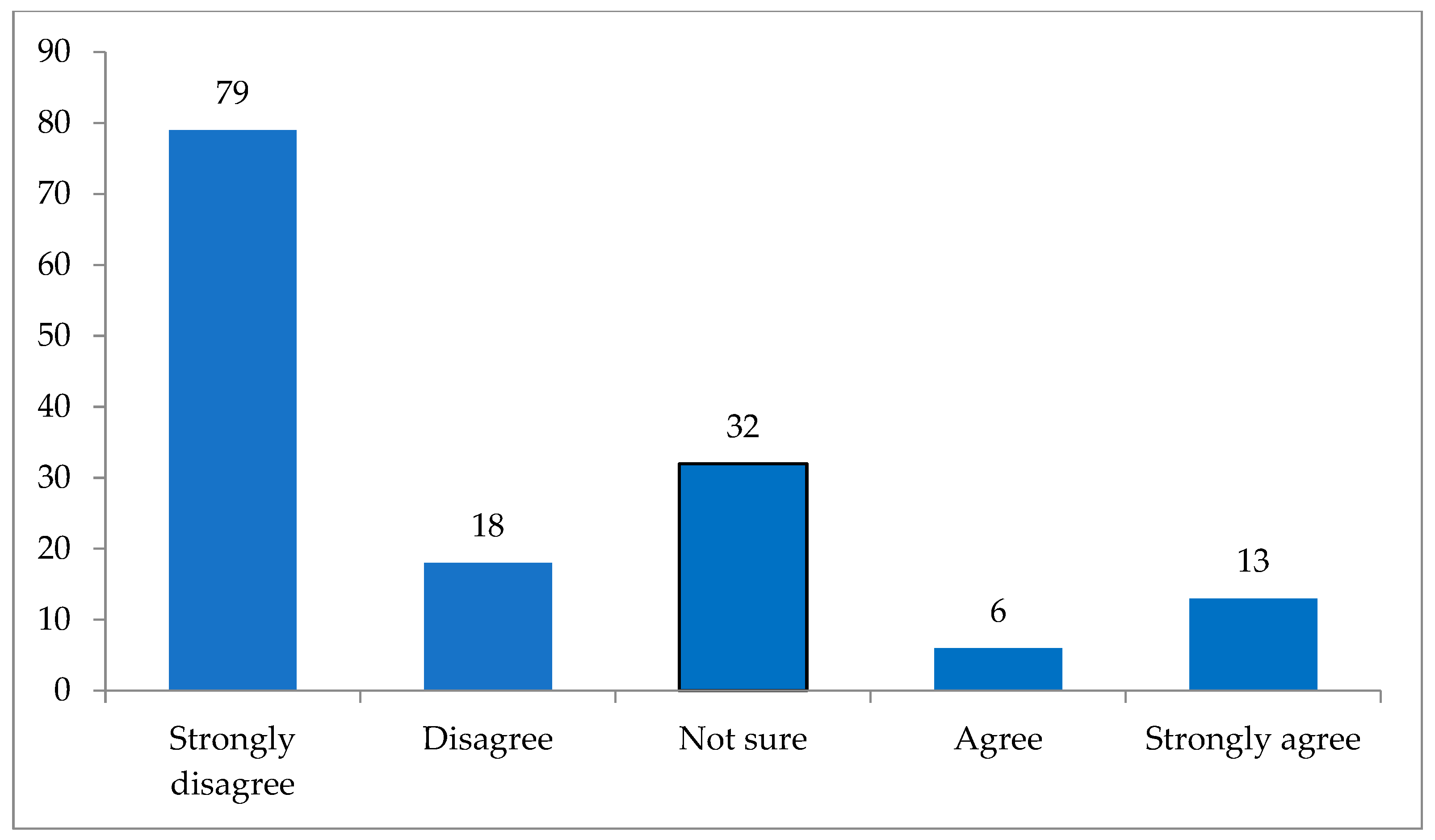
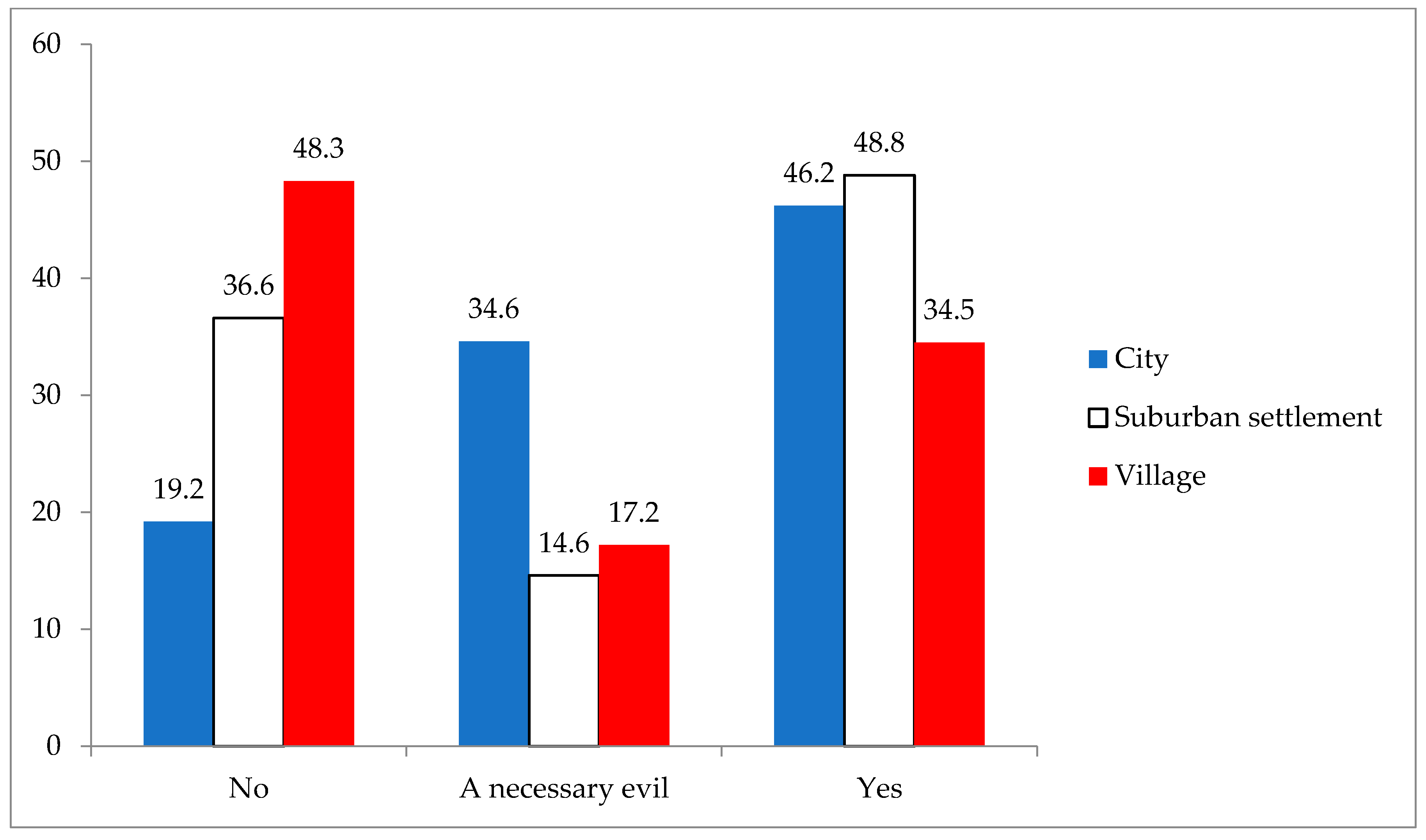
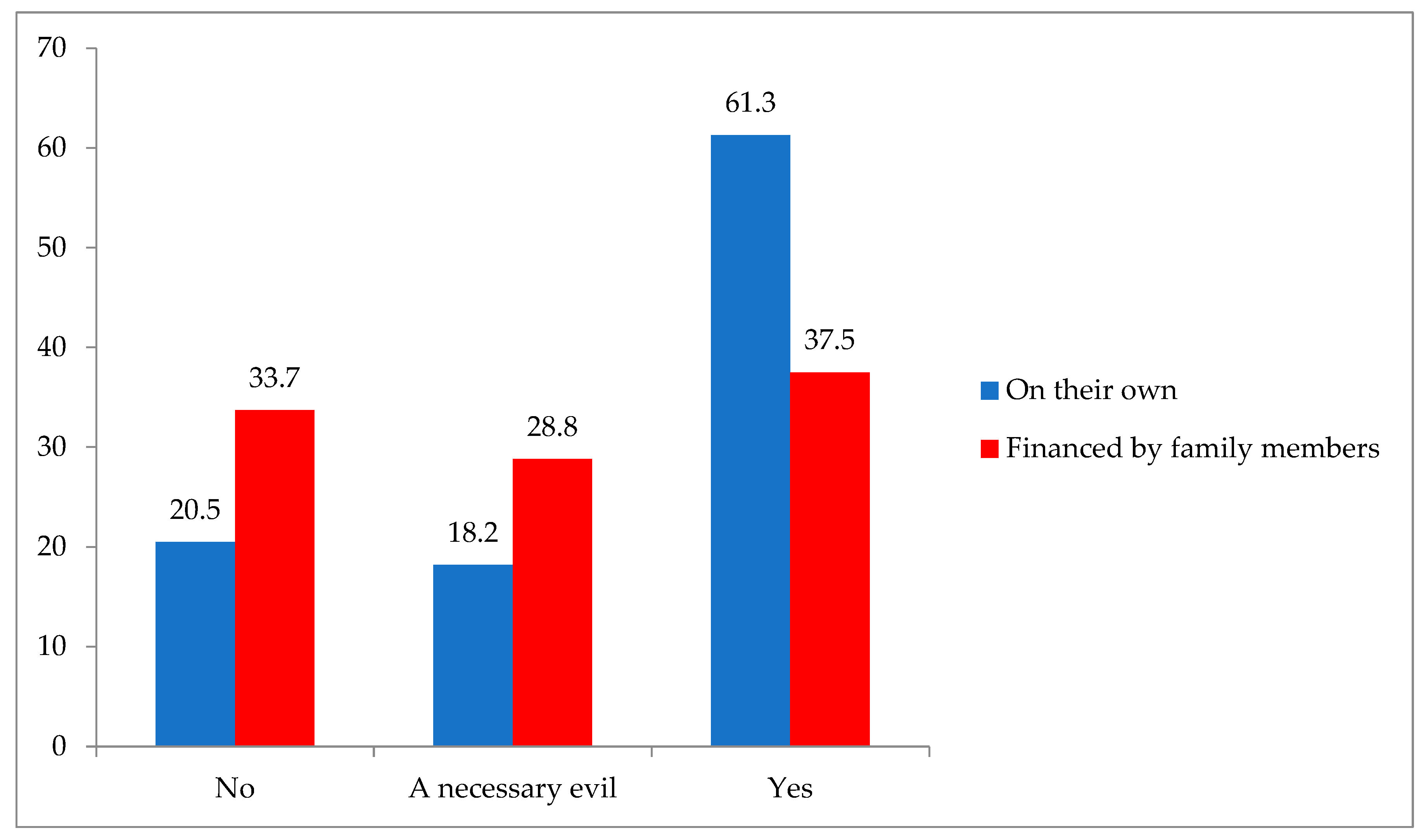
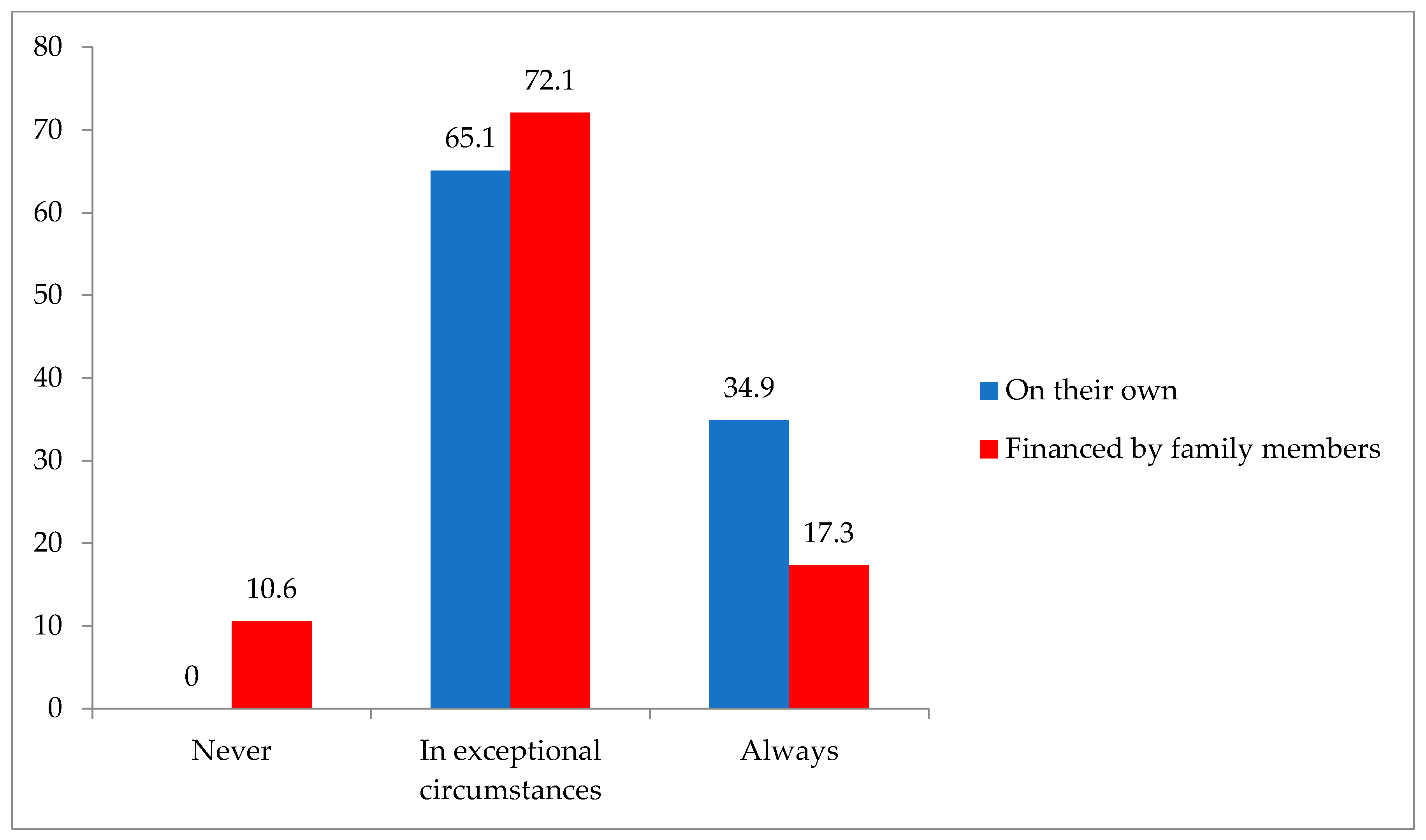
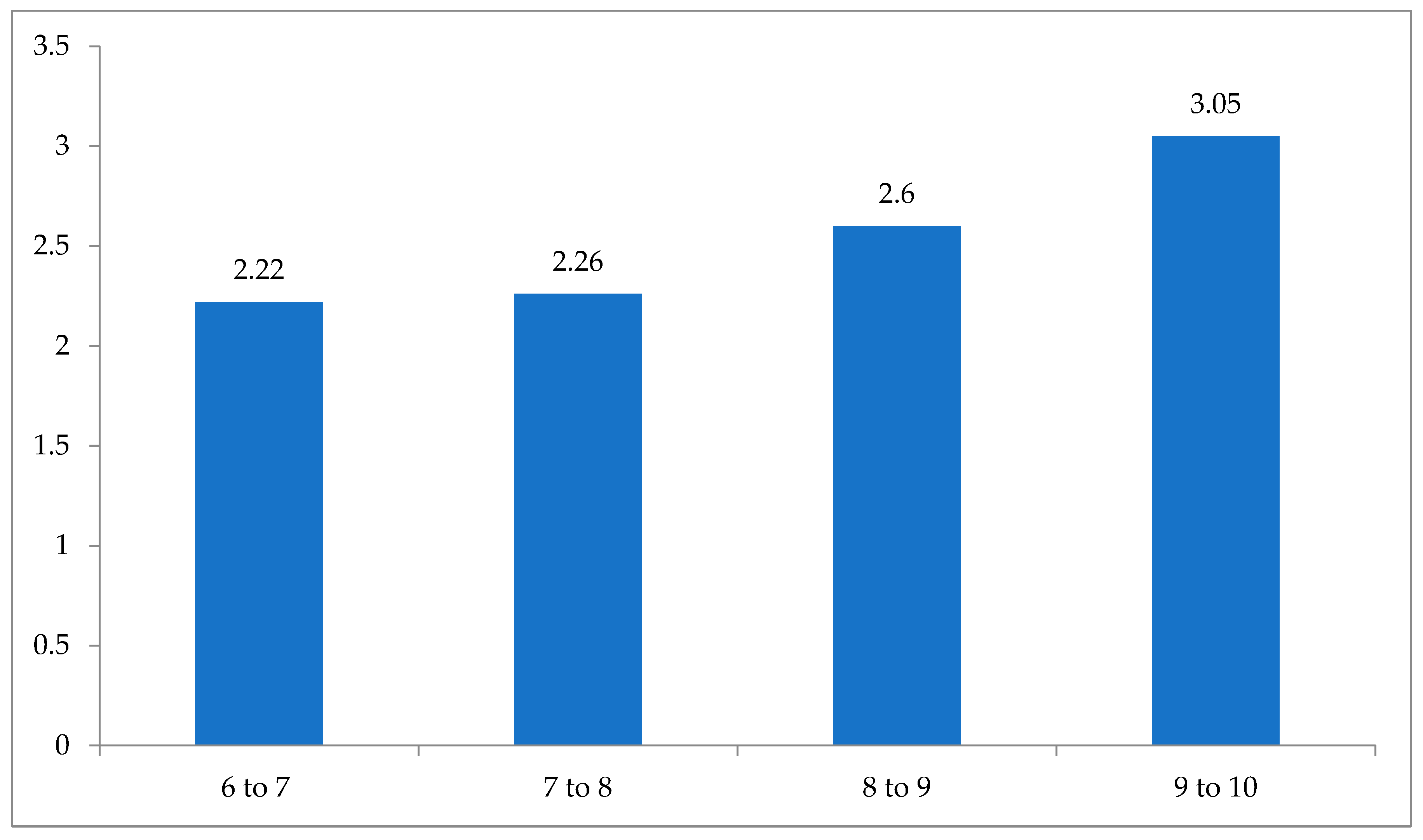
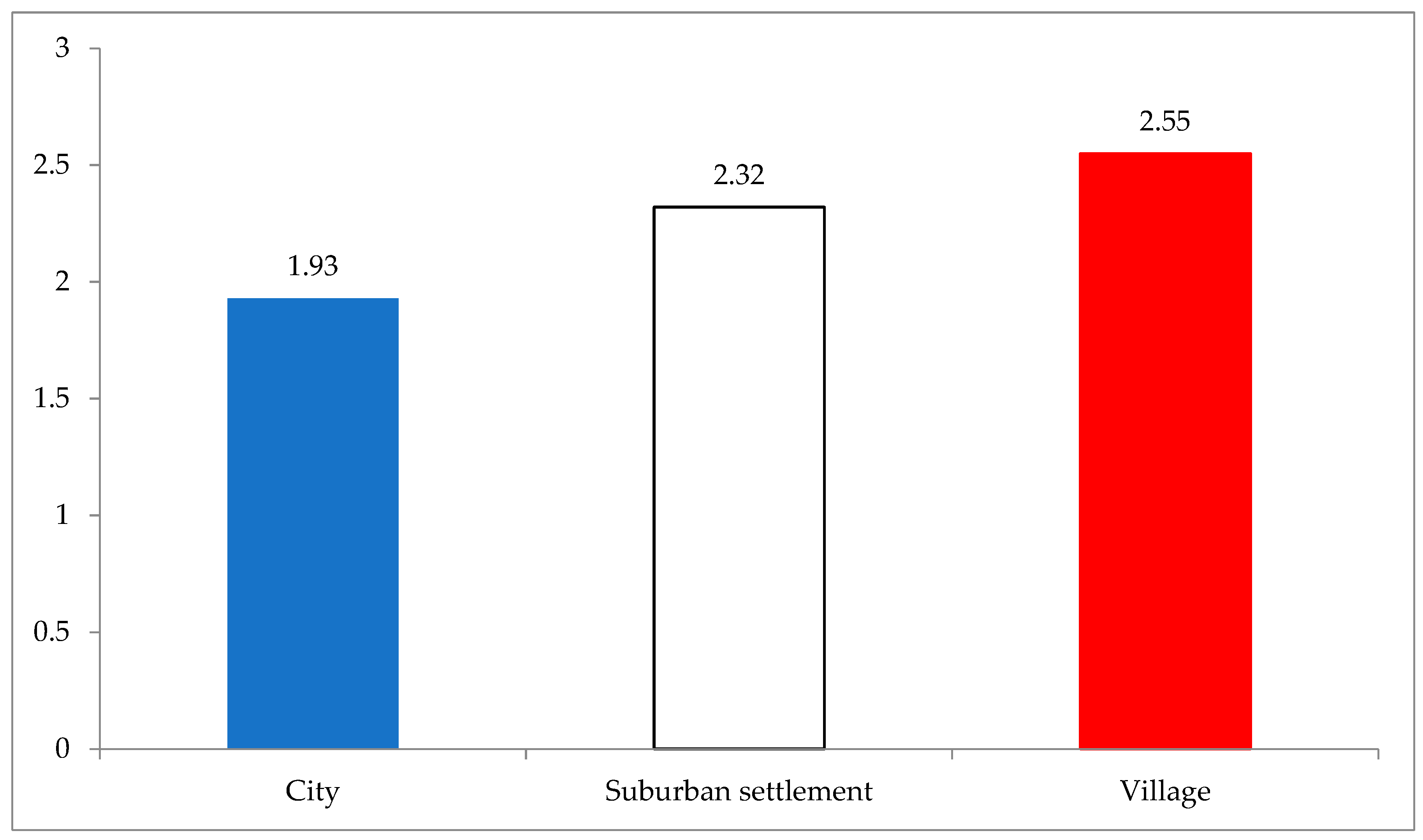

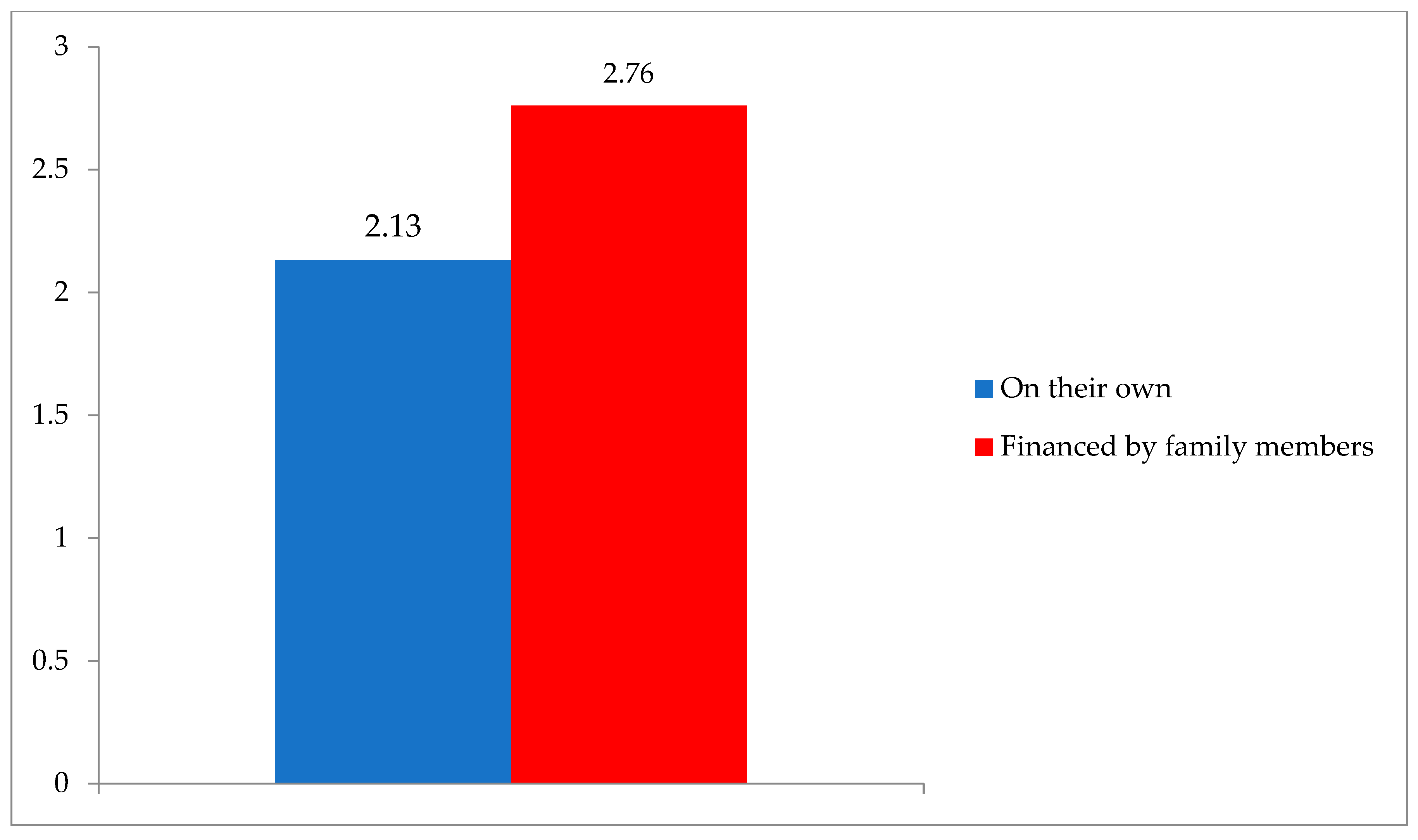
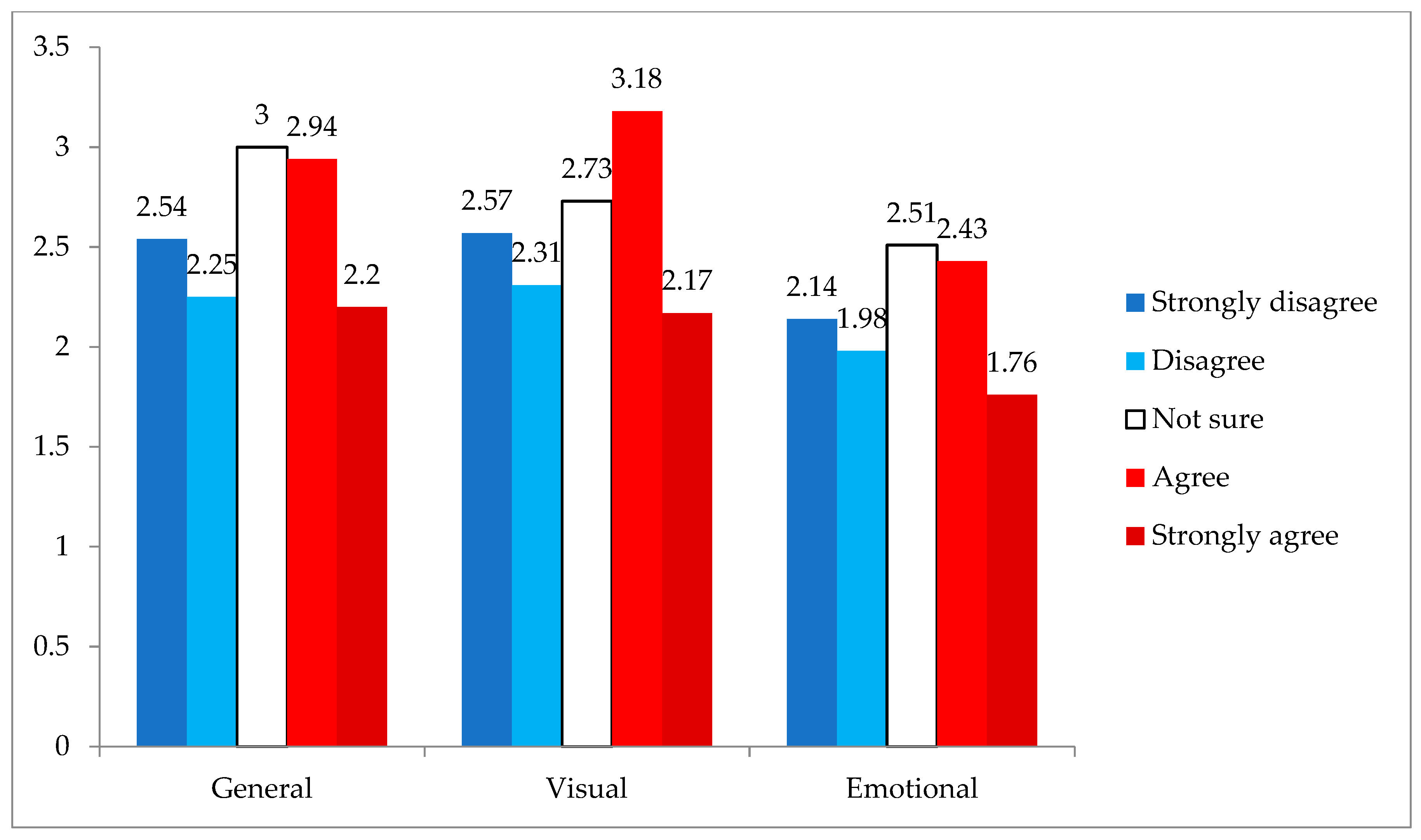
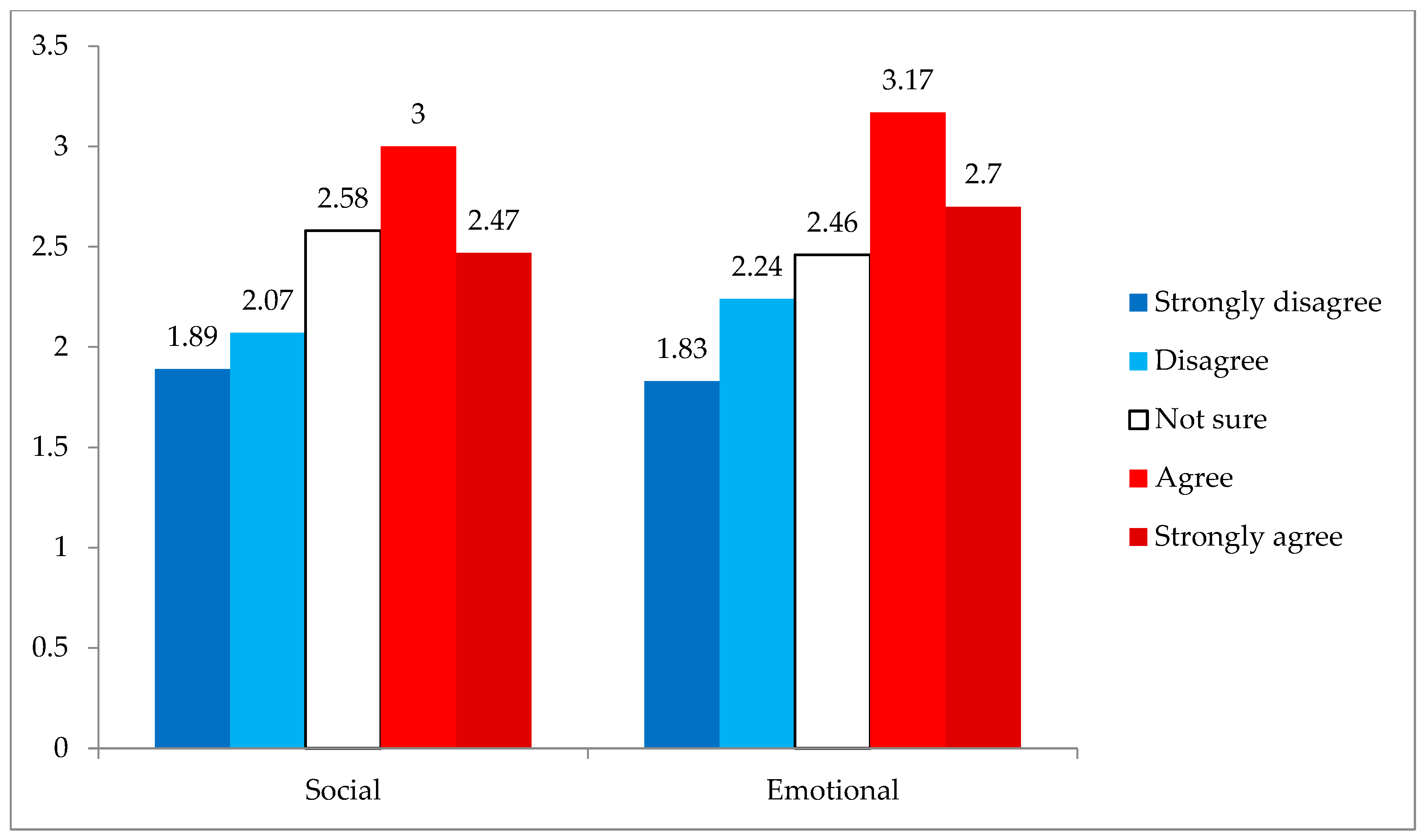

| Level of Academic Studies | Students’ Status | GPA | |||||
|---|---|---|---|---|---|---|---|
| Basic | Master’s | Budget | Self-financing | 6 to 7 | 7 to 8 | 8 to 9 | 9 to 10 |
| 86 | 62 | 113 | 35 | 9 | 47 | 59 | 33 |
| Method of Financing Studies | Monthly Household Income | |||||
|---|---|---|---|---|---|---|
| financed by family members | the student works and finances the costs of studying on his/her own | much below average | below average | average | above average | much above average |
| 44 | 104 | 32 | 24 | 45 | 29 | 18 |
| How Much the Students Liked ERT | In Which Circumstances Students Found It Acceptable to Attend RT Again | ||||
|---|---|---|---|---|---|
| I did not like it at all | I saw it as a necessary evil | I liked it very much | Never | In extraordinary circumstances | To introduce it as a permanent form of teaching |
| 44 | 38 | 66 | 11 | 103 | 33 |
| Scales | α | M | SD |
|---|---|---|---|
| General fatigue | 0.83 | 2.58 | 1.19 |
| Visual | 0.89 | 2.57 | 1.26 |
| Social | 0.85 | 2.16 | 1.17 |
| Motivational | 0.87 | 2.35 | 1.21 |
| Emotional | 0.91 | 2.14 | 1.14 |
| Total | 0.97 | 2.33 | 1.09 |
| R | R2 | Adjusted R2 | F | p | Partial | p | |
|---|---|---|---|---|---|---|---|
| General | |||||||
| GPA, | 0.555 | 0.308 | 0.214 | 3.284 | 0.000 | 0.224 | 0.014 |
| Monthly household income and | −0.193 | 0.035 | |||||
| ERT preference | −0.194 | 0.034 | |||||
| Visual | |||||||
| Students’ status and | 0.596 | 0.355 | 0.269 | 4.123 | 0.000 | −0.196 | 0.030 |
| attitude toward the possibility of attending RT again | −0.0248 | 0.002 | |||||
| Social | |||||||
| Monthly household income and | 0.531 | 0.282 | 0.186 | 2.940 | 0.000 | −0.211 | 0.020 |
| ERT preference | −0.181 | 0.047 | |||||
| Motivational | |||||||
| Monthly household income | 0.552 | 0.273 | 0.176 | 2.810 | 0.001 | −0.229 | 0.011 |
| Emotional | |||||||
| GPA, | 0.56 | 0.321 | 0.228 | 3.432 | 0.000 | 0.186 | 0.044 |
| Monthly household income | −0.200 | 0.030 | |||||
| and the opinion about the difficulty in attending ERT due to the lack of money for purchasing the internet, | 0.234 | 0.011 | |||||
| and attitude toward the possibility of attending RT again | −0.249 | 0.007 | |||||
| ZEF total score | |||||||
| GPA, | 0.553 | 0.306 | 0.209 | 3.169 | 0.000 | 0.202 | 0.029 |
| Monthly household income, | −0.207 | 0.025 | |||||
| and attitude toward the possibility of attending RT again | −0.188 | 0.043 | |||||
Disclaimer/Publisher’s Note: The statements, opinions and data contained in all publications are solely those of the individual author(s) and contributor(s) and not of MDPI and/or the editor(s). MDPI and/or the editor(s) disclaim responsibility for any injury to people or property resulting from any ideas, methods, instructions or products referred to in the content. |
© 2025 by the authors. Licensee MDPI, Basel, Switzerland. This article is an open access article distributed under the terms and conditions of the Creative Commons Attribution (CC BY) license (https://creativecommons.org/licenses/by/4.0/).
Share and Cite
Petrović, J.R.; Nikolić, I.A.; Šuvaković, U.V. The Effect of Students’ Material Status and Zoom Fatigue on Their Perception of Emergency Remote Teaching Satisfaction and Remote Teaching Sustainability from the Perspective of Education Faculty Students in Serbia. Sustainability 2025, 17, 9052. https://doi.org/10.3390/su17209052
Petrović JR, Nikolić IA, Šuvaković UV. The Effect of Students’ Material Status and Zoom Fatigue on Their Perception of Emergency Remote Teaching Satisfaction and Remote Teaching Sustainability from the Perspective of Education Faculty Students in Serbia. Sustainability. 2025; 17(20):9052. https://doi.org/10.3390/su17209052
Chicago/Turabian StylePetrović, Jelena R., Ivko A. Nikolić, and Uroš V. Šuvaković. 2025. "The Effect of Students’ Material Status and Zoom Fatigue on Their Perception of Emergency Remote Teaching Satisfaction and Remote Teaching Sustainability from the Perspective of Education Faculty Students in Serbia" Sustainability 17, no. 20: 9052. https://doi.org/10.3390/su17209052
APA StylePetrović, J. R., Nikolić, I. A., & Šuvaković, U. V. (2025). The Effect of Students’ Material Status and Zoom Fatigue on Their Perception of Emergency Remote Teaching Satisfaction and Remote Teaching Sustainability from the Perspective of Education Faculty Students in Serbia. Sustainability, 17(20), 9052. https://doi.org/10.3390/su17209052






